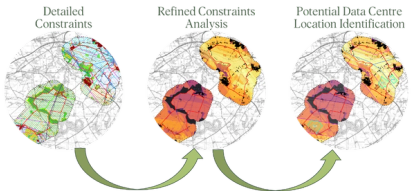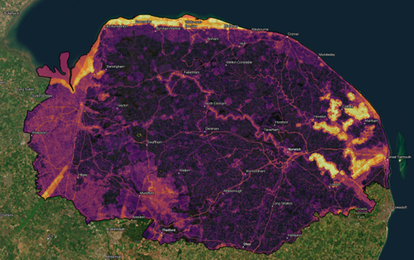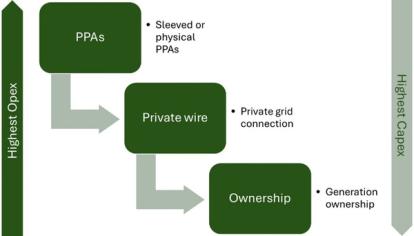
When the power grid is unavailable for data centre power: Screening data centre sites with geospatial machine learning and options
- Post Date
- 23 July 2025
- Read Time
- 5 minutes

The SLR data centre thought leadership series continues with the final instalment of a three-part focus on the power grid. For data centre operators in mature markets globally, SLR has developed a unique geospatial analysis tool informed by machine learning to accelerate site selection and weight drivers for selection and prioritisation. Additionally, where power is unavailable, we can support clients with alternative primary energy strategies leveraging our knowledge of microgrids and industrial decarbonisation.
Identifying optimal data centre locations requires a multidisciplinary approach that integrates geospatial intelligence, energy systems modelling, and regulatory foresight. SLR applies advanced geospatial analysis techniques, including machine learning-assisted mapping, to evaluate land availability, grid infrastructure, environmental constraints, and climate resilience. These datasets are used to inform infrastructure routing and site selection decisions, balancing planning risk with grid access potential.
SLR's geospatial workflow leverages supervised and unsupervised machine learning models to generate constraint maps and opportunity heatmaps. These models incorporate:
- Land use and planning datasets
- Transmission and distribution network topology
- Environmental and ecological constraints
- Climate projections and resilience scenarios
An example application in Norfolk demonstrates how machine learning-enabled heatmap modelling can visualise optimal zones for data centre development based on multi-criteria spatial analysis.



Decentralised energy modelling for grid-constrained regions
In regions with limited grid headroom, decentralised energy solutions offer viable alternatives. SLR conducts high-level techno-economic assessments of:
- Renewable Power Purchase Agreements (PPAs) and private wire connections
- Co-location with Combined Heat and Power (CHP) or biomass facilities
- On-site solar PV and battery storage integration
These assessments consider annual and lifetime OPEX, asset utilisation, and site competitiveness. Hybrid inverter systems are analysed using quasi-dynamic simulations to evaluate power quality and system utilisation under variable demand profiles. This enables investors to assess return on investment based on energy intake/offtake dynamics and hybrid system performance.
Decentralised energy solutions reduce reliance on constrained grid infrastructure and helpfully contribute to ESG and sustainability targets. We often see that phased deployment is possible, providing energy resilience in early development while full grid capacity is being secured providing for more optionality during development.
Energy economics and risk simulation
Electricity is one of the largest operating expenses for data centres, second only after paying for compute. Strategy is informed through our techno-economics-risk simulation of energy opex. In combination with our clients or third-party market forecasters, SLR can help assess long-term energy costs, annual energy cost variability, price volatility, resilience strategies, and carbon exposure. This analysis helps to inform primary data centre energy strategy, backup power planning, and contract structure. We work with clients to align assumption books prior to simulation. We can also simulate market changes where we combine inputs from the client / third party market curve forecasters to see, for example, what might happen when a power market reform takes place from a single market price to a nodal pricing mechanism. As lower nodal price signals manifest, this has the potential to relocate some of the centre of data centre gravity within a country’s geography to lower priced areas, and put incumbent low latency locations at an even higher price premium.
By combining cost modelling with infrastructure options, we empower clients to make informed trade-offs between CAPEX, OPEX, resilience, and sustainability for energy and cooling. We can model scope 1 and 2 carbon emissions as well as scope 1 and 2 water use as part of our energy-economics-risk simulation. This may be hybridised solutions as hybridised cooling solutions are offered to the market for AI as well as other data centre occupiers.

Planning, policy and regulations: power market reforms keep on moving
Grid connection is not just technical - it can also be a regulatory roller coaster. SLR supports clients through:
- Power system design and compliance
- Environmental and land use planning
- Energy policy alignment
Our cross-jurisdictional experience ensures that infrastructure and operational considerations are embedded in early-stage planning, reducing delays and improving project viability.
Accelerating the route to final investment decision
Power availability is increasingly a gating factor for data centre development. SLR integrates geospatial, techno-economic, and regulatory analysis to streamline the path to Final Investment Decision (FID). Our approach supports direct grid connection, on-site generation, and hybrid energy models tailored to operator KPIs.
Five key takeaways:
- Geospatial efficiency: Machine learning-enabled mapping accelerates constraint analysis and site prioritisation.
- Energy simulation depth: Tier-based modelling incorporates extensive variables and time-series data to assess energy and cooling economics.
- Integrated analysis: Combining geospatial and energy simulations provides a robust framework for site evaluation.
- Risk characterisation: Monte carlo methods support bespoke risk-return modelling for investment committees and boards.
- Microgrid optimisation: Where grid access is delayed, SLR models microgrid configurations aligned with uptime tiers and energy resilience goals.
Recent posts
-

-

-

Transforming the Food & Beverage industry: From compliance only to business-driven decarbonisation
by Vincenzo Giordano, Joseph Payne, Stéphane Rapoport
View post